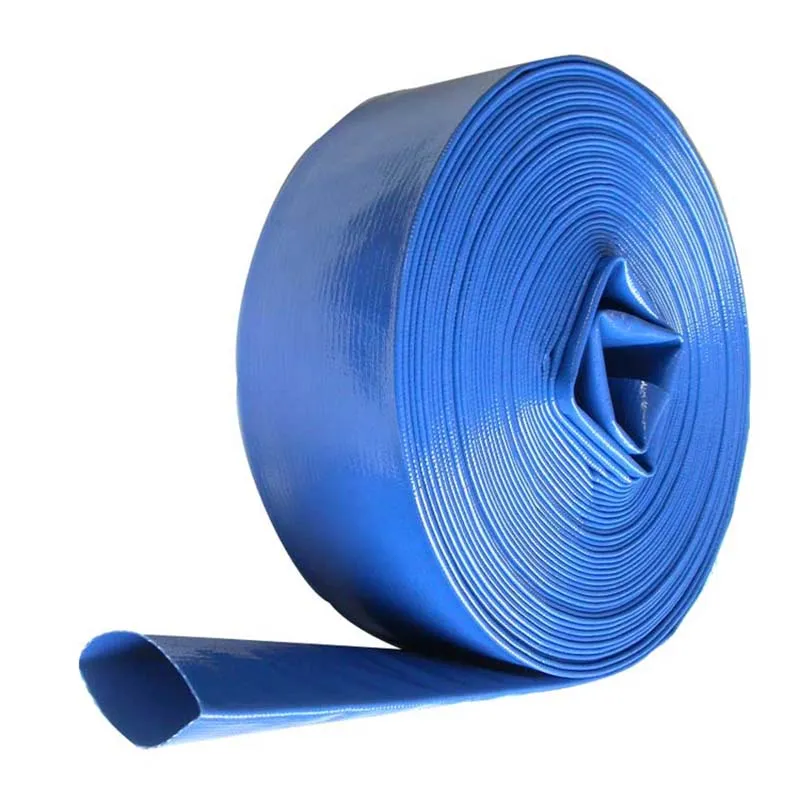Lay Flat Hose
Lay Flat Hose
Construction Materials
Typically, lay flat hose is made of high-quality synthetic materials such as PVC or nitrile rubber, which ensures durability and resistance to abrasion, chemicals, and UV exposure.
Reinforcement: Lay flat hose incorporates reinforcement layers, often polyester or high-strength fibers, providing structural integrity and preventing hose distortion under pressure.
Design Characteristics
Flat Shape: Unique flat profile when not in use, allowing for convenient storage, transportation, and deployment. The flat design minimizes space requirements and simplifies handling compared to traditional hoses.
Flexibility: Despite the flat structure, these hoses exhibit flexibility during use, accommodating bending and folding without compromising flow efficiency.
Multiple Applications
Construction and Mining: Suited for temporary fluid transport needs on construction sites and in mining operations due to easy handling and rapid deployment.
Oil and Fuel Transfer: Some lay flat hoses are compatible with oil and fuel transfer applications, providing a versatile solution for various industries.
Performance Features
Low Friction Loss: Engineered to minimize friction loss during fluid transport, ensuring efficient water or liquid transfer over extended lengths.
High Burst Pressure: Designed to withstand high-pressure conditions, enhancing safety and reliability in demanding industrial environments.
Temperature Resistance: Capable of handling a broad temperature range, making them suitable for diverse climates and applications.
Multiple Applications: lay flat irrigation hoses come in various sizes and diameters to accommodate different flow rates and suction requirements. Proper sizing for any lay flat discharge hose is crucial for optimizing performance and preventing excessive pressure drops.
PVC HEAVY LAYFLAT HOSE
Frequently Asked Questions
Welcome to our Lay Flat Hose FAQ section. Here, we address common queries about our high-quality industrial lay flat hoses which are designed for robust service in various applications. If you have additional questions, feel free to contact our experts for personalized assistance.
What is an industrial lay flat hose?
Answer: An industrial lay flat hose is a flexible, collapsible hose designed for efficient fluid transfer where the fluid is under pressure. Its flat design allows for easy storage and transport when not in use.
What materials are lay flat hoses made from?
Answer: Lay flat hoses are commonly made from PVC, polyurethane, or nitrile rubber. Material choice depends on factors like chemical compatibility, flexibility, and durability.
How do lay flat hoses differ from traditional hoses?
Answer: Lay flat hoses distinguish themselves by their flat, collapsible design, making them easy to store. They are typically lightweight and flexible, suitable for temporary or portable fluid transfer.
What are the most critical advantages of lay flat hoses?
Answer: Lay flat hoses offer benefits such as ease of handling, quick deployment, kink resistance, and the ability to cover large areas. They are also cost-effective and easy to transport.
Can lay flat hoses handle high-pressure applications?
Answer: Lay flat hoses are generally designed for low to medium-pressure applications. Specialized versions with reinforced layers may handle higher pressures, but choosing the right type for the application is crucial.
Can lay flat hoses handle abrasive materials?
Answer: Lay flat hoses can handle some abrasion, but using reinforced lay flat hoses with specialized abrasion-resistant materials is recommended for abrasive applications.
What considerations are important when selecting lay flat hoses?
Answer: Consider factors like material compatibility, pressure requirements, temperature range, flexibility, and abrasion resistance. Choose hoses that meet industry standards and are suitable for the specific application.
Are lay flat hoses suitable for potable water applications?
Answer: Yes, lay flat hoses made from materials approved for potable water use are available. Always check the hose specifications and certifications to ensure compliance with drinking water standards.
How do I determine the right size of lay flat hose for my application?
Answer: Consider the required flow rate, pressure, and the distance the hose must cover. Consult manufacturer specifications and charts to choose the appropriate diameter and length for optimal performance.
What maintenance is required for industrial suction hoses?
Answer: Regular inspection for wear, damage, or deterioration is essential. Proper storage away from sunlight and chemicals, along with correct fittings and couplings, contributes to longevity.
Are lay flat hoses suitable for transferring chemicals?
Answer: Depending on the material composition, lay flat hoses can be suitable for chemical transfer. Verifying chemical compatibility and choosing hoses designed for chemical applications is essential.
How do you store and maintain lay flat irrigation hoses?
Answer: Store lay flat irrigation hoses flat, away from direct sunlight and extreme temperatures. Regularly inspect for abrasions, punctures, or kinks. Clean hoses after use and follow manufacturer guidelines for maintenance.
How do I determine the right size of lay flat hose for my application?
Answer: Consider the required flow rate, pressure, and the distance the hose must cover, especially when working with lay flat hose. Consult manufacturer specifications and charts to choose the appropriate diameter and length for optimal performance.
-
Welded Wire Mesh Panel: Durable, Versatile, and AffordableNewsJul.28,2025
-
Top Quality Oxy Acetylene Hoses for Sale Fit for Welding DemandsNewsJul.28,2025
-
The Future of Pneumatic Air Tubes in IndustryNewsJul.28,2025
-
Superior and Reliable LPG Hose Pipe Solutions for Every NeedNewsJul.28,2025
-
Exceptionally Durable and Versatile Premium Braided PVC TubingNewsJul.28,2025
-
Best Adapters for Connecting Garden Hose to PVC Pipe ConnectionsNewsJul.28,2025















